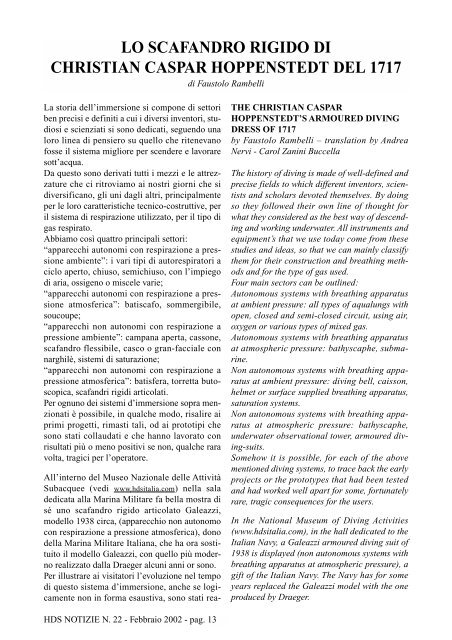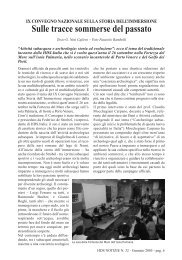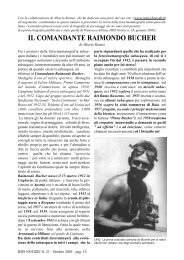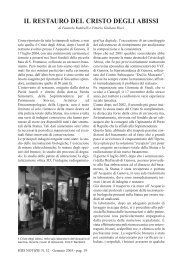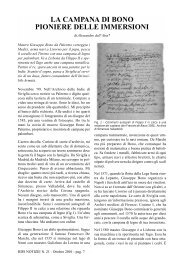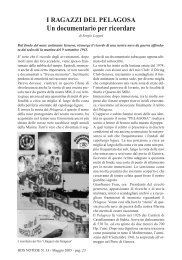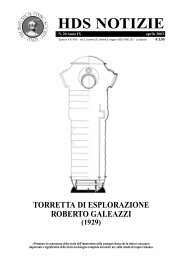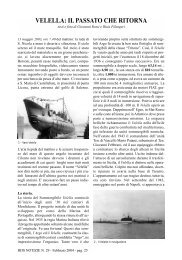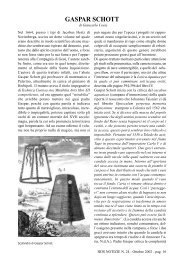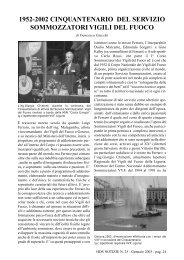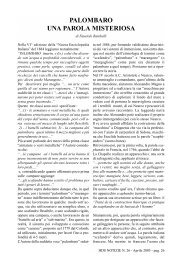hds internet - The Historical Diving Society Italia
hds internet - The Historical Diving Society Italia
hds internet - The Historical Diving Society Italia
Create successful ePaper yourself
Turn your PDF publications into a flip-book with our unique Google optimized e-Paper software.
LO SCAFANDRO RIGIDO DI<br />
CHRISTIAN CASPAR HOPPENSTEDT DEL 1717<br />
di Faustolo Rambelli<br />
La storia dell’immersione si compone di settori<br />
ben precisi e definiti a cui i diversi inventori, studiosi<br />
e scienziati si sono dedicati, seguendo una<br />
loro linea di pensiero su quello che ritenevano<br />
fosse il sistema migliore per scendere e lavorare<br />
sott’acqua.<br />
Da questo sono derivati tutti i mezzi e le attrezzature<br />
che ci ritroviamo ai nostri giorni che si<br />
diversificano, gli uni dagli altri, principalmente<br />
per le loro caratteristiche tecnico-costruttive, per<br />
il sistema di respirazione utilizzato, per il tipo di<br />
gas respirato.<br />
Abbiamo così quattro principali settori:<br />
“apparecchi autonomi con respirazione a pressione<br />
ambiente”: i vari tipi di autorespiratori a<br />
ciclo aperto, chiuso, semichiuso, con l’impiego<br />
di aria, ossigeno o miscele varie;<br />
“apparecchi autonomi con respirazione a pressione<br />
atmosferica”: batiscafo, sommergibile,<br />
soucoupe;<br />
“apparecchi non autonomi con respirazione a<br />
pressione ambiente”: campana aperta, cassone,<br />
scafandro flessibile, casco o gran-facciale con<br />
narghilè, sistemi di saturazione;<br />
“apparecchi non autonomi con respirazione a<br />
pressione atmosferica”: batisfera, torretta butoscopica,<br />
scafandri rigidi articolati.<br />
Per ognuno dei sistemi d’immersione sopra menzionati<br />
è possibile, in qualche modo, risalire ai<br />
primi progetti, rimasti tali, od ai prototipi che<br />
sono stati collaudati e che hanno lavorato con<br />
risultati più o meno positivi se non, qualche rara<br />
volta, tragici per l’operatore.<br />
All’interno del Museo Nazionale delle Attività<br />
Subacquee (vedi www.<strong>hds</strong>italia.com) nella sala<br />
dedicata alla Marina Militare fa bella mostra di<br />
sé uno scafandro rigido articolato Galeazzi,<br />
modello 1938 circa, (apparecchio non autonomo<br />
con respirazione a pressione atmosferica), dono<br />
della Marina Militare <strong>Italia</strong>na, che ha ora sostituito<br />
il modello Galeazzi, con quello più moderno<br />
realizzato dalla Draeger alcuni anni or sono.<br />
Per illustrare ai visitatori l’evoluzione nel tempo<br />
di questo sistema d’immersione, anche se logicamente<br />
non in forma esaustiva, sono stati rea-<br />
THE CHRISTIAN CASPAR<br />
HOPPENSTEDT’S ARMOURED DIVING<br />
DRESS OF 1717<br />
by Faustolo Rambelli – translation by Andrea<br />
Nervi - Carol Zanini Buccella<br />
<strong>The</strong> history of diving is made of well-defined and<br />
precise fields to which different inventors, scientists<br />
and scholars devoted themselves. By doing<br />
so they followed their own line of thought for<br />
what they considered as the best way of descending<br />
and working underwater. All instruments and<br />
equipment’s that we use today come from these<br />
studies and ideas, so that we can mainly classify<br />
them for their construction and breathing methods<br />
and for the type of gas used.<br />
Four main sectors can be outlined:<br />
Autonomous systems with breathing apparatus<br />
at ambient pressure: all types of aqualungs with<br />
open, closed and semi-closed circuit, using air,<br />
oxygen or various types of mixed gas.<br />
Autonomous systems with breathing apparatus<br />
at atmospheric pressure: bathyscaphe, submarine.<br />
Non autonomous systems with breathing apparatus<br />
at ambient pressure: diving bell, caisson,<br />
helmet or surface supplied breathing apparatus,<br />
saturation systems.<br />
Non autonomous systems with breathing apparatus<br />
at atmospheric pressure: bathyscaphe,<br />
underwater observational tower, armoured diving-suits.<br />
Somehow it is possible, for each of the above<br />
mentioned diving systems, to trace back the early<br />
projects or the prototypes that had been tested<br />
and had worked well apart for some, fortunately<br />
rare, tragic consequences for the users.<br />
In the National Museum of <strong>Diving</strong> Activities<br />
(www.<strong>hds</strong>italia.com), in the hall dedicated to the<br />
<strong>Italia</strong>n Navy, a Galeazzi armoured diving suit of<br />
1938 is displayed (non autonomous systems with<br />
breathing apparatus at atmospheric pressure), a<br />
gift of the <strong>Italia</strong>n Navy. <strong>The</strong> Navy has for some<br />
years replaced the Galeazzi model with the one<br />
produced by Draeger.<br />
HDS NOTIZIE N. 22 - Febbraio 2002 - pag. 13


